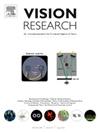Human trichromacy and refractive development
IF 1.4
4区 心理学
Q4 NEUROSCIENCES
引用次数: 0
Abstract
In the post-natal developing eye, there is an active process of refractive development in which the neural retina uses optical cues to evaluate focus, and adjusts the rate of axial elongation to first achieve, and then actively maintain as the optics continue to mature, sharp focus: the process of emmetropization. Increasingly it looks as if chromatic cues are essential (if not exclusive) for this process.
Nearly all non-primate mammals are dichromats, with short- and relatively long-wavelength sensitive cones. However, most humans are trichromats, with short-, medium-, and long-wavelength sensitive cones—although many humans are dichromats like non-primate mammals (“red-green color blind”). This leads to two related questions: is trichromacy important for human emmetropization, and do experimental results from dichromatic mammals apply to humans?
The issue is far from settled, but the available evidence indicates that emmetropization in humans is likely functionally dichromatic similar to that of other mammals, with the medium- and long-wavelength sensitive cones effectively pooled into a single functional “long” cone. In support of this, human dichromats generally emmetropize as well as human trichromats, and they also become myopic to a roughly similar proportion. Trichromacy does not appear to be of fundamental importance for refractive development in humans. While there is some evidence that dichromats might be slightly less susceptible to becoming myopic than human trichromats, the data are inconclusive. Further studies on this topic may lead to an improved understanding of why emmetropization increasingly fails leading to myopia development in humans.
人类的三色和屈光发育
在出生后发育的眼睛中,存在一个主动的屈光发育过程,在这个过程中,神经视网膜利用光学线索来评估焦点,并调节轴向伸长的速率,以首先实现,然后随着光学的不断成熟而主动保持,尖锐的焦点:正视化过程。在这个过程中,音色线索似乎越来越重要(如果不是唯一的话)。几乎所有的非灵长类动物都是二色视者,具有短波长和相对较长的敏感视锥细胞。然而,大多数人都是三色视者,具有短波、中波和长波敏感锥体——尽管许多人像非灵长类哺乳动物一样是二色视者(“红绿色盲”)。这就引出了两个相关的问题:三色对人类的异色化很重要吗?二色哺乳动物的实验结果是否也适用于人类?这个问题还远没有解决,但现有的证据表明,人类的异色化很可能在功能上与其他哺乳动物相似,中长波长敏感的视锥细胞有效地集中在一个单一的功能“长”视锥细胞中。为了支持这一观点,人类二色视者通常会像人类三色视者一样近视,他们也会以大致相似的比例近视。三色似乎对人类屈光发育并不具有根本的重要性。虽然有一些证据表明,二色视者比三色视者更不容易近视,但这些数据还没有定论。对这一主题的进一步研究可能有助于更好地理解为什么正视化越来越失败导致人类近视的发展。
本文章由计算机程序翻译,如有差异,请以英文原文为准。
求助全文
约1分钟内获得全文
求助全文
来源期刊

Vision Research
医学-神经科学
CiteScore
3.70
自引率
16.70%
发文量
111
审稿时长
66 days
期刊介绍:
Vision Research is a journal devoted to the functional aspects of human, vertebrate and invertebrate vision and publishes experimental and observational studies, reviews, and theoretical and computational analyses. Vision Research also publishes clinical studies relevant to normal visual function and basic research relevant to visual dysfunction or its clinical investigation. Functional aspects of vision is interpreted broadly, ranging from molecular and cellular function to perception and behavior. Detailed descriptions are encouraged but enough introductory background should be included for non-specialists. Theoretical and computational papers should give a sense of order to the facts or point to new verifiable observations. Papers dealing with questions in the history of vision science should stress the development of ideas in the field.
 求助内容:
求助内容: 应助结果提醒方式:
应助结果提醒方式:


